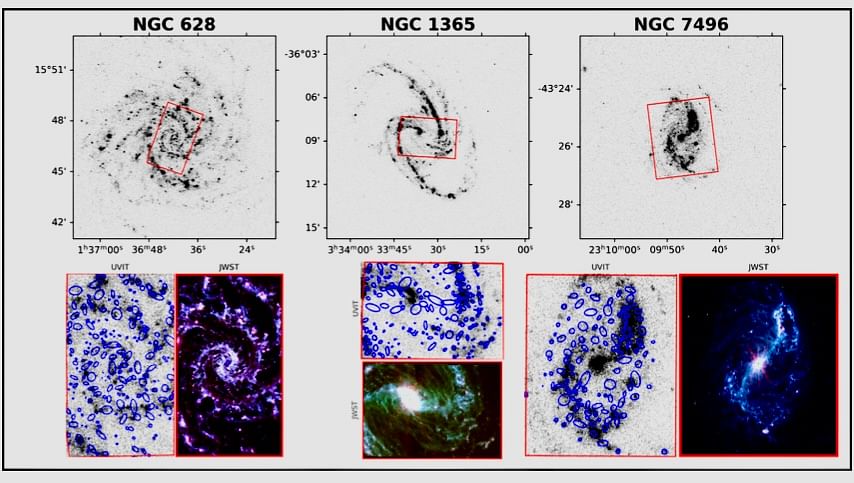
Image caption: UVIT and JWST images of the galaxy samples are displayed in top and bottom panels, with the JWST observation field indicated in the UVIT Far UV images.
Credit: Research Team
Bengaluru: The complex relationship between Polycyclic Aromatic Hydrocarbon (PAH) molecules and the formation of stars could find new directions from a recent study by a team of Bengaluru-based researchers.
In a first, the researchers fused high-resolution images from the UltraViolet Imaging Telescope (UVIT) aboard the Indian Space Research Organisation (Isro)’s AstroSat and the James Webb Space Telescope (JWST), to investigate the impact of star formation on the properties of PAH molecules.
Carbon is believed to exist in the interstellar medium largely in the form of PAHs which also account for about 20% of infrared emissions in star-forming galaxies. PAHs have been indirectly associated with star formation but poor understanding of their properties has limited the utility of PAH emission as an indicator of star-forming activity.
Active star-forming regions also emit UV radiation in large amounts, leaving these regions marked brightly in the UV images. This makes UV emission, when compared with PAHs, a more direct indicator of star formation.
The researchers used the JWST images to identify regions with the brightest PAH emission and then turned to the corresponding UVIT images to track the UV emission from the same region and estimate the star formation rate. Correlating the two sets of data, they were able to conclude that the fraction of smaller and ionised (electrically charged) PAHs is higher in regions with high star formation rates. UV photons in regions with higher star-forming activity could be the reason for the increased presence of these charged molecules, the researchers suggested.
Ujjwal Krishnan, a final year research scholar at CHRIST (Deemed to be University), Bengaluru, led the study which investigated three nearby galaxies: NGC 628, NGC 1365, and NGC 7496. The paper has been accepted for publication in the international journal Astronomy and Astrophysics.
Integrating data:
Ujjwal said the complementary use of the two telescopes' distinct observing capabilities set an important template for future studies. “For this investigation, it was important that we generated high-quality data, both in the UV and infrared ranges. While the UVIT images enabled an estimation of the star formation rates, the range of JWST filters helped us study PAH emissions on a resolved scale,” he told DH.
Sreeja S. Kartha, co-author of the paper and faculty at CHRIST’s Department of Physics and Electronics, said the integration of data from the two telescopes allowed researchers to access intricate details that would have, otherwise, remained hidden.
Blesson Mathew, Akhil Krishna R, Sudheesh T P, and Robin Thomas, all from CHRIST, and Smitha Subramanian from the Indian Institute of Astrophysics (IIA), Bengaluru, are the other co-authors.
Studies have consistently pointed to PAHs’ presence in space but the first direct observation was reported only in March 2021, when a team of researchers led by MIT Assistant Professor Brett McGuire identified two PAHs in a molecular cloud.
The JWST, launched in December 2021, carries a suite of advanced instruments for observations in the infrared range. It is a collaborative mission involving NASA, the European Space Agency, and the Canadian Space Agency. The UVIT, developed by IIA, comes with Far UV, Near UV and visible band imagers. It was launched onboard the AstroSat mission in September 2015.